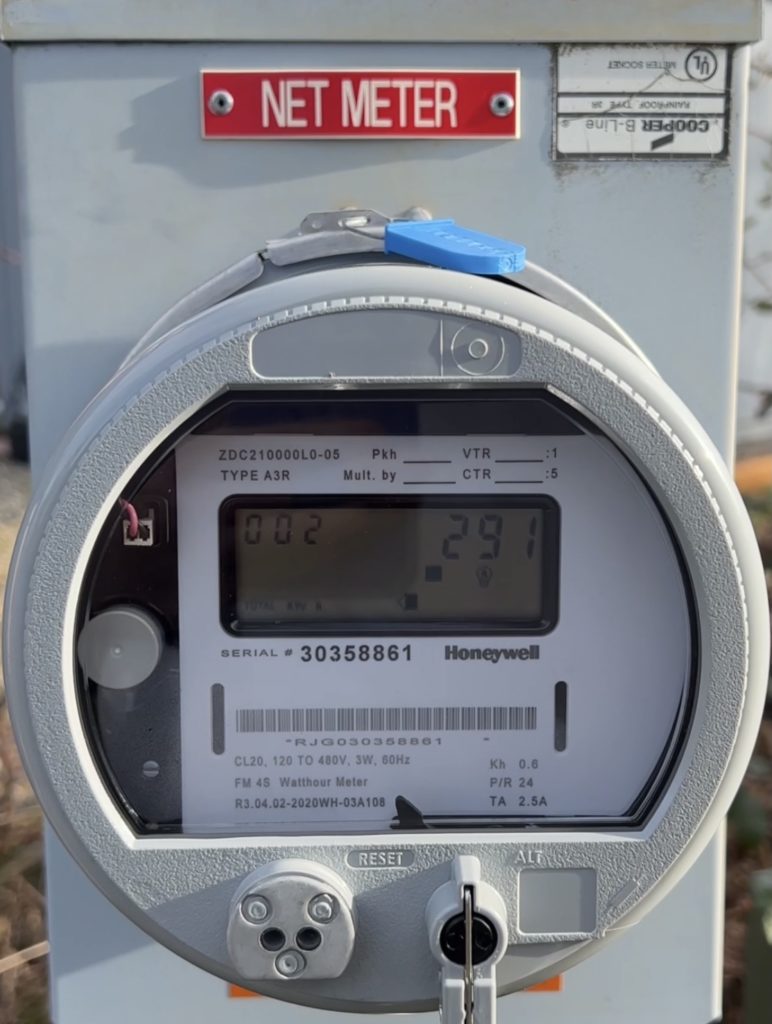Making Solar Possible
The keystone of residential and commercial solar is net metering. Net metering allows homeowners who have solar systems to send their excess energy production back to the grid. The power company then credits homeowners for the kilowatt-hours they produce. This allows people to use the electricity from solar panels at any time rather than only at the time of production. Otherwise you would need to invest in battery storage systems that can be costly. The grid becomes an unlimited battery for solar owners and if people need extra electricity they can still pull from it like they used to.
Net metered systems have a bi-directional meter that spins backwards When energy is being produced. Then it spins forwards when pulled from the grid. Some people produce more than they need and won’t have a utility bill on top of their solar payments. Others supplement their energy and pay the net cost after their credits help pay the utility bill.
1-1 Net Metering
Net metering is an agreement with states and utility companies to allow people to utilize the grid in this way. There are actually many differences in what states and utility companies offer for energy production compensation. The method that allows the most people to benefit from owning their own power is 1-1 annual net metering.
With 1-1, you get compensated at the same rate as purchasing, and production is tracked and rolled over every month throughout the year. This promotes solar adoption as well as helps utilities with their grid infrastructure issues. Many cost benefit analysis studies go over the range of benefits from solar adoption. SEIA has many articles about solar and net metering, as well as links to meta studies on the costs and benefits of net metering itself.

Think Roll Over Minutes
Solar companies and the people who help create a system design for your home, like myself, think about production in annual kWhs needed and created. This works the best for net metering programs that are at a 1-1 ratio. Every excess watt you produce, the grid gives you a watt back. Some companies even pay for excess at the end of the year, some don’t.
Almost every person in every state with a good roof will have a time of year where they produce more energy with their panels than they consume. This is usually the summer for many people. Come winter, panels will have created a surplus of energy that the grid has tracked and will give to you at no extra charge when you need it. This makes it so people can effectively produce all the power they need and the only money they give to the utility company is the connection fee to be grid tied.
Benefits
Net metering has a range of studied benefits that exceed the scope of this blog. There are many resources for further explanation of the environmental, economic, public health, grid security and job creation impacts of net metering. One obvious benefit, especially during these pandemic times, is indeed job creation. “Net metering increases demand for solar energy, which in turn creates jobs for the installers, electricians, and manufacturers who work in the solar supply chain. Today, the solar industry employs more than 230,000 American workers in large part due to strong state net metering policies which have allowed the solar industry to thrive.”
https://www.seia.org/initiatives/net-metering
Net Metering Under Attack
There are policies being worked on that may drastically change net metering. Some changes are trying to help all shareholders and make progress in solar adoption and grid infrastructure. Some changes discourage solar adoption and claim that it is not a benefit. Many studies dispute this claim. Crossborder did a comprehensive study of net metering in California. They concluded, “On average over the residential markets of the state’s three big IOUs, NEM does not impose costs on non-participating ratepayers, and instead creates a small net benefit.”
People are on the case for advocating for keeping net metering or even making positive improvements to it. Arnold Schwarzenegger wrote about it for New York Times.
https://www.nytimes.com/2022/01/17/opinion/schwarzenegger-solar-power-california.html
Your Solution
Currently, regardless of possible changes to net metering, purchasers of solar panels can get grandfathered into local net metering programs. Some programs range around 10 to 25 years. Contact us If you would like to get locked in and hedge against rising rates and policies subject to change. Sustainable Solutions can create a complimentary, custom solar design for your home. Click here to get a free solar design and estimate.
